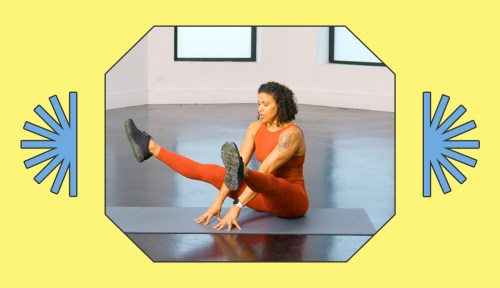Mastering This Move Will Help You Work Up to a Handstand—While Sitting on the Floor
The seated straddle raise will work the whole front of your core and even help you work up to a handstand from the comfort of the floor.

Staying up in a handstand is a challenge on its own, but getting upside down in the first place is no small feat. You’ll have to engage your arms, back, and lats for your base, while also using the strength in your core, glutes, and quads to actually hoist those legs overhead.
Experts in This Article
Elisabeth Akinwale, CPT, is a CrossFit Athlete, CrossFit Coach, and gymnast.
This can be exhausting to practice, and just trying to get up in a handstand again and again might see you relying more on momentum than actually building the necessary muscles. That’s why the seated straddle raise, which you can practice right from the comfort of the good ol’ floor, is a great place to start.
“The seated straddle raise is really common in gymnastics circles,” says Elisabeth Akinwale, a certified personal trainer with a background in competitive gymnastics, who is leading Well+Good’s ReNew Year movement plan this month. “It’s a great exercise for working the whole front side of your core.” That includes your hip flexors, abs, and your quads.
In a new video for Well+Good, Akinwale explains how to master this deceptively challenging move, which involves raising and lowering your legs while your bum remains on the ground.
Begin in a straddle position with your legs slightly wider than shoulder-width apart, and place your hands on the floor in between your thighs. Lock your knees and elbows, and engage your quads, arms, and back. Then, raise and lower both legs at the same time in a fluid, controlled motion.
But watch out: There are a few common mistakes people make in this move. Make sure to keep your legs straight, avoiding a bend in your knees. Raise both legs at the same time, not one at a time. And make sure you’re not hiking up your shoulders towards your ears—engaging your lats in your back will help.
Akinwale explains that the motion of the seated straddle is very similar to a handstand or toe raise because it involves the same motion.
“Part of the objective is to be closing that angle between your torso and your legs, so you’re getting that compression in your body, similar to a compressed handstand, or a toe raise,” Akinwale says. “This one might look easy but I guarantee you it’s harder than it looks.” Watch the full video to get her best tips on how to make it happen.
Sign Up for Our Daily Newsletter
Get all the latest in wellness, trends, food, fitness, beauty, and more delivered right to your inbox.
Got it, you've been added to our email list.










